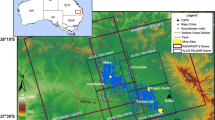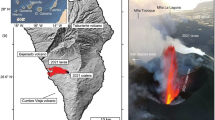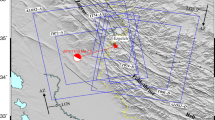Abstract
The combined effects of active tectonics and anthropogenic activities, primarily geothermal resources exploitation for electricity production in Cerro Prieto geothermal field, influence the ground surface deformation in Cerro Prieto basin, Baja California, Mexico. In this study, a large set of multi-sensor C-band SAR images have been employed to reconstruct the spatiotemporal evolution of aseismic ground surface deformation that has affected Cerro Prieto basin from 1993 to 2014. Conventional DInSAR together with the interferograms stacking procedure was applied. The results showed that the study area presented considerable surface deformation (mainly subsidence) during the entire time of the investigation. The main changes in rate and pattern of surface deformation have a good correlation in time and space with the changes in production in the Cerro Prieto geothermal field. Comparison of LOS displacement maps from different viewing geometries, and decomposition (where possible) of LOS displacement into vertical and horizontal (east–west) components, revealed considerable horizontal displacement which mostly reflects the ground movement at and beyond the margin of the subsidence basin toward the areas of highest subsidence rates. In addition, the validation of the DInSAR results by comparing them against measurements from leveling surveys was performed, confirming the high reliably of satellite interferometry for the ground surface deformation rate mapping in the study area.







Modified from Sarychikhina et al. (2016)



Modified from Sarychikhina et al. (2016)








Similar content being viewed by others
References
Arellano VM, Barragán RM, Aragón A, Izquierdo G, Portugal E, Rodríguez MH, Pérez A (2010) Reservoir characteristics and exploitation-related processes at the CP IV sector of the Cerro Prieto (México) geothermal field. In: Proceedings of the World Geothermal Congress 2010, Bali, Indonesia
Bennett RA, Rodi W, Reilinger RE (1996) Global Positioning System constraints on fault slip rates in southern California and northern Baja, Mexico. J Geophys Res 101(B10):21943–21960
Berardino P, Fornaro G, Lanari R, Sansosti E (2002) A new algorithm for surface deformation monitoring based on small baseline differential SAR interferograms. IEEE Trans Geosci Remote Sens 40:2375–2383
Biggs J, Wright T, Lu Z, Parsons B (2007) Multi-interferogram method for measuring interseismic deformation: Denali fault, Alaska. Geophys J Int 170:1165–1179. https://doi.org/10.1111/j.1365-246X.2007.03415.x
Buckley SM (2000) Radar interferometry measurement of land subsidence. Ph.D. thesis, The University of Texas at Austin, Texas, USA
Camacho Ibarra E (2006) Análisis de la deformación vertical del terreno en la región de confluencia del sistema de fallas Cerro Prieto-Imperial en el periodo 1962–2001. M.Sc. thesis, Department of Geophysics, CICESE, Ensenada, B.C., Mexico
Carnec C, Fabriol H (1999) Monitoring and modeling land subsidence at the Cerro Prieto geothermal field, Baja California, Mexico, using SAR interferometry. Geophys Res Lett 26(9):1211–1214
CFE (2010) Cerro Prieto Geothermal Field. CFE, Residencia General de Cerro Prieto, p 46
Costantini M (1998) A novel phase unwrapping method based on network programming. IEEE Trans Geosci Remote Sens 36(3):813–821
Costantini M, Farina A, Zirilli F (1999) A fast phase unwrapping algorithm for SAR interferometry. IEEE Trans Geosci Remote Sens 37(1):452–460
Crosetto M, Monserrat O, Iglesias R, Crippa B (2010) Persistent scatterer interferometry: potential, limits and initial C- and X-band comparison. Photogr Eng Remote Sens 76:1061–1069
Dai K, Liu G, Li Z, Li T, Yu B, Wang X, Singleton A (2015) Article extracting vertical displacement rates in Shanghai (China) with multi-platform SAR images. Remote Sens. 7:9542–9562. https://doi.org/10.3390/rs70809542
de Boer J (1980) Paleomagnetism of the Quaternary Cerro Prieto, Crater Elegante, and Salton Buttes volcanic domes in the northern part of the Gulf of California rhombochasm. Lawrence Berkeley Laboratory, Berkeley LBL-9742
Ding XL, Liu GX, Li ZW, Chen YQ (2004) Ground subsidence monitoring in Hong Kong with satellite SAR interferometry. Photogramm Eng Remote Sens 70(10):1151–1156
Elders WA, Rex RW, Meidav T, Robinson PT, Biehler S (1972) Crustal spreading in southern California. Science 178:15–24
Elliott JR, Biggs J, Parsons B, Wright TJ (2008) InSAR slip rate determination on the Altyn Tagh Fault, northern Tibet, in the presence of topographically correlated atmospheric delays. Geophys Res Lett 35:L12309. https://doi.org/10.1029/2008gl033659
Farr TG, Rosen PA, Caro E, Crippen R, Duren R, Hensley S, Kobrick M, Paller M, Rodriguez E, Roth L, Seal D, Shaffer S, Shimada J, Umland J, Werner M, Oskin M, Burbank D, Alsdorf D (2007) The shuttle radar topography mission. Rev Geophys 45(2):RG2004. https://doi.org/10.1029/2005rg000183
Ferretti A, Prati C, Rocca F (2000) Nonlinear subsidence rate estimation using permanent scatterers in differential SAR interferometry. IEEE Trans Geosci Remote Sens 38:2202–2212
Ferretti A, Prati C, Rocca F (2001) Permanent scatterers in SAR interferometry. IEEE Trans Geosci Remote Sens 391:10–20
Ferretti AA, Fumagalli F, Novali C, Prati F, Rocca Rucci A (2011) A new algorithm for processing interferometric data-stacks: Squeesar. IEEE Trans Geosci Remote Sens 49(9):3460–3470. https://doi.org/10.1109/tgrs.2011.2124465
Fialko Y (2006) Interseismic strain accumulation and the earthquake potential on the southern San Andreas fault system. Nature 441:968–971. https://doi.org/10.1038/nature04797
Flores-Armenta M, Ramírez-Montes M, Morales-Alcalá L (2014) Geothermal activity and development in Mexico–keeping the production going. Presented at “Short Course VI on Utilization of Low- and Medium-Enthalpy Geothermal Resources and Financial Aspects of Utilization”, organized by UNU-GTP and LaGeo, in Santa Tecla, El Salvador, 23–29 March, 2014. http://www.os.is/gogn/unu-gtp-sc/UNU-GTP-SC-18-03.pdf.
Gabriel AK, Goldstein RM, Zebker HA (1989) Mapping small elevation changes over large areas: differential SAR interferometry. J Geophys Res 94(B7):9183–9191
García JR (1978) Estudios de nivelación de primer orden en Cerro Prieto. In: Proceedings of First symposium on the Cerro Prieto geothermal field, Baja California, Mexico, pp 148–150
Gens R, van Genderen JL (1996) SAR interferometry: issues, techniques, applications. Int J Remote Sens 17(10):1803–1835
Glowacka E (1996) Vertical creepment in the southern part of imperial fault (Mexico). In: Proceedings of AGU fall meeting 1996, San Francisco, CA, USA
Glowacka E, Nava FA (1996) Major earthquake in Mexicali Valley, Mexico, and fluid extraction at Cerro Prieto geothermal field. Bull Seismol Soc Am 86:93–105
Glowacka E, González J, Fabriol H (1999) Recent vertical deformation in Mexicali Valley and its relationship with tectonics, seismicity, and the exploitation of the Cerro Prieto geothermal field, Mexico. Pure Appl Geophys 156(4):591–614
Glowacka E, González JJ, Nava FA, Farfán F, Díaz de Cossío G (2001) Monitoring surface deformations in the Mexicali valley, B.C., Mexico. In: Proceedings of tenth international symposium on deformation measurements, Orange, California, USA, pp 175–183
Glowacka E, Sarychikhina O, Nava FA (2005) Subsidence and stress change in the Cerro Prieto geothermal field, B.C, México. Pure Appl Geophys 162:2095–2110
Glowacka E, Sarychikhina O, Suárez F, Mendoza R, Nava FA (2006) Estudio geológico para definir la zona de hundimiento con el fin de relocalización del canal Nuevo Delta en el Valle de Mexicali. Reporte Técnico. CICESE, México, p 505
Glowacka E, Sarychikhina O, Suárez-Vidal F, Nava FA, Farfan F, Cossio Battani GD, Guzmán M (2007) Aseismic slip observed on the faults in Mexicali Valley, Baja California, Mexico. In: Proceedings of AGU spring meeting
Glowacka E, Sarychikhina O, Vázquez González R, Nava FA, Munguía L, Farfan F, Diaz De Cossio G, Garcia Arthur MA (2008) Slow aseismic slip in the pull-apart center of Cerro Prieto (Baja California, Mexico), from geotechnical instruments and InSAR observations. In: Proceedings of SSA 2008 annual meeting, Seismological Society of America, Santa Fe, New Mexico, USA, 79, p 282
Glowacka E, Sarychikhina O, Suárez F, Nava FA, Mellors R (2010) Anthropogenic subsidence in the Mexicali Valley, Baja California, Mexico, and slip on the Saltillo fault. Environ Earth Sci 59(7):1515–1524
Glowacka E, Sarychikhina O, Robles B, Suarez Vidal F, Ramírez Hernández J, Nava FA (2012) Estudio geológico para definir la línea de hundimiento cero y monitorear la subsidencia de los módulos 10, 11 y 12 en el Valle de Mexicali, en el distrito de riego 014. Reporte Final, Rio Colorado, B.C.
Goldstein RM, Werner CL (1998) Radar interferogram filtering for geophysical applications. Geophys Res Lett 25(21):4035–4038
González J, Glowacka E, Suárez F, Quiñones JG, Guzmán M, Castro JM, Rivera F, Félix MG (1998) Movimiento reciente de la Falla Imperial, Mexicali, B. C. Ciencia para todos Divulgare, Universidad Autónoma de Baja California 6(22):4–15
Grannell RB, Tarnman DW, Clover RC, Leggewie RM, Aronstam PS, Kroll RC, Eppink J (1979) Precision gravity studies at Cerro Prieto. In: Proceedings of second symposium on the Cerro Prieto geothermal field, Baja California, Mexico, Lawrence Berkeley Laboratory, Berkeley, California, pp 329–331
Gutiérrez-Negrín L (2012) Update of the geothermal electric potential in Mexico. GRC Trans 36:671–677
Gutiérrez-Negrín L, Maya-González R, Quijano JL (2010) Current Status of geothermics in Mexico. In: Proceedings of World Geothermal Congress 2010, International Geothermal Association (IGA), Bali, Indonesia
Gutiérrez-Negrín L, Maya-González R, Quijano-León JL (2015) Present situation and perspectives of geothermal in Mexico. In: Proceedings of World Geothermal Congress 2015, International Geothermal Association (IGA), Melbourne, Australia
Hanssen RF (2001) Radar interferometry. Data interpretation and error analysis. Kulwer Academic Publisher, Dordrecht
Hooper A, Zebker H, Segall P, Kampes B (2004) A new method for measuring deformation on volcanoes and other natural terrains using InSAR persistent scatterers. Geophys Res Lett 31:611–615
Kampes B (2006) Radar interferometry: persistent scatterer technique. Remote sensing and digital processing, vol 12. Springer, Dordrecht
Lachenbruch AH, Sass JH, Galains SP (1985) Heat flow in southernmost California and the origin of the Salton Trough. J Geophys Res 90(B8):6709–6736
Larsen S, Reilenger R (1991) Age constraints for the present fault configuration in the Imperial Valley, California: evidence for northwestward propagation of the Gulf of California rift system. J Geophys Res 96:10339–10346
Lippmann MJ, Bodvarsson GS (1983) Numerical studies of the heat and mass transport in the Cerro Prieto geothermal field, Mexico. Water Resour Res 19(3):753–767
Lippmann MJ, Truesdell AH, Mañón AM, Halfman SE (1991) A review of the hydrogeologic-geochemical model for Cerro Prieto. Geothermics 20:39–52
Lira H (1999) Resultados de la nivelación de precisión realizada con GPS, en 1998, en el campo geotérmico de Cerro Prieto. Informe Técnico RE 16/98, Comisión Federal de Electricidad, Residencia de Estudios, México, 30 pp
Lira H (2005) Actualización del modelo geológico conceptual del yacimiento Geotérmico de Cerro Prieto. Geotermia, Revista Mexicana de Geoenergía 18(1):37–46
Lira H (2006) Características del sismo del 23 de Mayo de 2006. Informe RE-023/2006, Comisión Federal de Electricidad, Residencia de Estudios, México
Lira H, Arellano JF (1997) Resultados de la nivelación de precisión realizada en 1997, en el campo geotérmico Cerro Prieto. Informe Técnico RE 07/97, Comisión Federal de Electricidad, Residencia de Estudios, México, 28 pp
Liu GX (2003) Mapping of earth deformations with satellite radar interferometry: a study of its accuracy and reliability performances. Ph.D. dissertation, The Hong Kong Polytechnic University, Hong Kong, China
Luo Q, Perissin D, Zhang Y, Jia Y (2014) L- and X-band multi-temporal InSAR analysis of Tianjin subsidence. Remote Sens. 6:7933–7951. https://doi.org/10.3390/rs6097933
Massonnet D, Feigl K (1998) Radar interferometry and its application to changes in the earth’s surface. Rev Geophys 36(4):441–500
Mercado S (1975) Movement of geothermal fluids and temperature distribution in Cerro Prieto geothermal field, Baja California, Mexico. In: Proceedings of second united nations symposium on the development and use of geothermal resources, San Francisco, USA: Washington, D.C., U.S. Government Printing Office (1), pp 487–494
Miranda-Herrera CA (2015) Geothermal and solar energy in Cerro Prieto. In: Proceedings of World Geothermal Congress 2015, International Geothermal Association (IGA), Melbourne, Australia
Ocampo-Díaz J, Valdez-Salaz B, Shorr M, Sauceda M, Rosas-González N (2005) Review of corrosion and scaling problems in Cerro Prieto geothermal field over 31 years of commercial operations. In: Proceedings of World Geothermal Congress 2005, International Geothermal Association (IGA), Antalya, Turkey
Pelayo A, Razo M, Gutiérrez LCA, Arellano GF, Espinoza JM, Quijano L (1991) Main geothermal fields of México; Cerro Prieto Geothermal Field, Baja California. In: The geology of North America, Geological Society of America, P-3, Economic Geology, México, pp. 23–58
Samieie-Esfahany S, Hanssen R, van Thienen-Visser K, Muntendam-Bos A (2009) On the effect of horizontal deformation on InSAR subsidence estimates. In: Proceedings of Fringe 2009 workshop, ESA SP-677
Sarychikhina O, Glowacka E (2015) Spatio-temporal evolution of aseismic ground deformation in the Mexicali Valley (Baja California, Mexico) from 1993 to 2010, using differential SAR interferometry. In: Proceedings of IAHS 372, pp 335–341. https://doi.org/10.5194/piahs-372-335-2015
Sarychikhina O, Glowacka E, Mellors R, Suárez-Vidal F (2011) Land subsidence in the Cerro Prieto geothermal field, Baja California, Mexico, from 1994 to 2005. An integrated analysis of DInSAR, leveling and geological data. J Volcanol Geothherm Res 204:76–90
Sarychikhina O, Glowacka E, Robles B, Nava FA, Guzman M (2015) Estimation of seismic and aseismic deformation in Mexicali Valley, Baja California, Mexico, in the 2006–2009 Period, using precise leveling, DInSAR, geotechnical instruments data, and modeling. Pure Appl Geophys 172:3139–3162. https://doi.org/10.1007/s00024-015-1067-0
Sarychikhina O, Glowacka E, Mojarro J (2016) Surface deformation associated with geothermal fluids extraction at the Cerro Prieto geothermal field, Baja California, Mexico revealed by DInSAR technique. In: Proceedings of living planet symposium 2016, Prague, Czech Republic, ESA SP-740
Scharroo R, Visser P (1998) Precise orbit determination and gravity field improvement for the ERS satellites. J Geophys Res 103(C4):8113–8127
Segall P (1989) Earthquakes triggered by fluid extraction. Geology 17(10):942–946
Suárez-Vidal F, Munguia-Orozco L, Gonzalez-Escobar M, Gonzalez-Garcia J, Glowacka E (2007) Surface rupture of the Morelia fault near the Cerro Prieto geothermal field, Mexicali, Baja California, Mexico, during the Mw 5.4 Earthquake of 24 May 2006. Seismol Res Lett 78(3):394–399
Suárez-Vidal F, Mendoza-Borunda R, Nafarrete-Zamarripa L, Rámirez J, Glowacka E (2008) Shape and dimensions of the Cerro Prieto pull-apart basin, Mexicali, Baja California, México, based on the regional seismic record and surface structures. Int Geol Rev 50(7):636–649
Terres R, Crowell JC (1979) Plate tectonic framework of the San Andreas-Salton trough juncture. In: Crowell JC, Sylvester AG (eds) Tectonics of the juncture between the San Andreas fault system and the Salton Trough, Southeastern California: Department of Geological Sciences, University of California Santa Barbara, pp 15–26
Truesdell A, Thompson JM, Copley TB, Nehring NL, Janik CJ (1981) The origin of the Cerro Prieto geothermal brine. Geothermics 10:225–238
Truesdell A, Lippmann M, Rodríguez M, Pérez A (2003) Influence of reservoir processes on gas in Cerro Prieto steam. Geotherm Res Counc Trans 27:335–340
Trugman DT, Borsa AA, Sandwell DT (2014) Did stresses from the Cerro Prieto geothermal field influence the El Mayor-Cucapah rupture sequence? Geophys Res Lett. https://doi.org/10.1002/2014GL061959
Velasco J (1963) Levantamiento Gravimétrico, Zona Geotérmica de Mexicali. Baja California. Reporte Interno, Consejo de Recursos Naturales no Renovables, p 55
Wegmuller U, Werner CL (1997) Gamma SAR processor and interferometry software. In: Proceedings of 3rd ERS symposium, European Space Agency special publications, ESA SP-414, pp 1686–1692
Werner C, Wegmuller U, Strozzi T, Wiesmann A (2000) Gamma SAR and interferometric processing software. In: Proceedings of ERS-ENVISAT symposium, European Space Agency, Gothenberg, Sweden
Werner C, Wegmuller U, Strozzi T, Wiesmann A (2003) Interferometric point target analysis for deformation mapping. Proc Geosci Remote Sens Symp 7:4362–4364
Wright T, Parsons B, Fielding E (2001) Measurement of interseismic strain accumulation across the North Anatolian Fault by satellite radar interferometry. Geophys Res Lett 28:2117–2120. https://doi.org/10.1029/2000GL012850
Wright TJ, Parsons B, England PC, Fielding EJ (2004a) InSAR observations of low slip rates on the major faults of western Tibet. Science 305:236–239. https://doi.org/10.1126/science.1096388
Wright TJ, Parsons BE, Lu Z (2004b) Towards mapping surface deformation in three dimensions using InSAR. Geophys Res Lett. https://doi.org/10.1029/2003GL018827
Zandbergen R, Otten M, Righetti PL, Kuijper D, Dow JM (2003) Routine operational and high-precision orbit determination of Envisat. Adv Space Res 31:1953–1958
Zebker HA, Villasenor J (1992) Decorrelation in interferometric radar echoes. IEEET Geosci Remote 30:950–959
Zebker HA, Rosen PA, Hensley S (1997) Atmospheric effects in interferometric synthetic aperture radar surface deformation and topographic maps. J Geophys Res 102(B4):7547–7563
Acknowledgements
The authors would like to acknowledge ESA for providing the satellite images in the framework of Cat-1 project (ID–C1P3508). The financial support from the CONACYT project 105907 and CICESE and IMTA internal funds is recognized. We appreciate the access to the 2012 leveling data funded by CONAGUA during the CICESE-CONAGUA, Cuenca Peninsular de Baja California Project. The authors greatly acknowledge the anonymous reviewer for careful reading of the manuscript and helpful comments and suggestions. The authors express sincere thanks to Dr. Alejandro Nava Pichardo for manuscript revision and constructive suggestions that improved the manuscript.
Author information
Authors and Affiliations
Corresponding author
Electronic supplementary material
Below is the link to the electronic supplementary material.
Appendix 1: Decomposition of los deformation
Appendix 1: Decomposition of los deformation
The DInSAR techniques (conventional and advanced approaches) measure ground deformation along the satellite LOS direction (slant range). For 3D displacement vector with components in up (\(D_{\text{U}}\)), east (\(D_{\text{E}}\)), and north (\(D_{\text{N}}\)) directions, the projected LOS deformation (\(D_{\text{LOS}} )\) is given by:
where \(\theta\) is the SAR incidence angle and \(\alpha\) is the azimuth of the satellite heading angle (positive clockwise from the north). \(D_{\text{LOS}}\) is defined here as positive for displacement toward the satellite. According to equation (A1.1), the sensitivity of a SAR sensor to displacement vector components can be expressed by the partial derivatives as follows:
The displacement direction and field cannot be recovered by DInSAR, unless at least three independent datasets, or the necessary assumptions based on previous knowledge about the ground deformation components, are available (Wright et al. 2004b).
Considering near-polar orbits and the incidence angle of past and current SAR satellites, DInSAR observations are mostly sensitive to the vertical displacement component while their sensitivity to the north component is minimal.
Purely vertical ground deformation is often assumed for subsidence monitoring using DInSAR techniques (e.g., Luo et al. 2014). Neglecting the horizontal displacement components (\(D_{\text{E}}\) and \(D_{\text{N}}\)), the vertical component (\(D_{\text{U}}\)) can then be retrieved from \(D_{\text{LOS}}\) using the sensor incidence angle (\(\theta )\):
However, ignoring the effect of potential horizontal components can introduce large errors in the final deformation estimates (Samieie-Esfahany et al. 2009). In cases in which DInSAR measurements from two different imaging geometries (i.e., ascending and descending orbits) are available, two of the three components can be retrieved by neglecting the third (usually north–south) component and solving the following linear system of equations:
where A and D refer to the ascending and descending orbit, respectively.
Rights and permissions
About this article
Cite this article
Sarychikhina, O., Glowacka, E. & Robles, B. Multi-sensor DInSAR applied to the spatiotemporal evolution analysis of ground surface deformation in Cerro Prieto basin, Baja California, Mexico, for the 1993–2014 period. Nat Hazards 92, 225–255 (2018). https://doi.org/10.1007/s11069-018-3206-2
Received:
Accepted:
Published:
Issue Date:
DOI: https://doi.org/10.1007/s11069-018-3206-2





